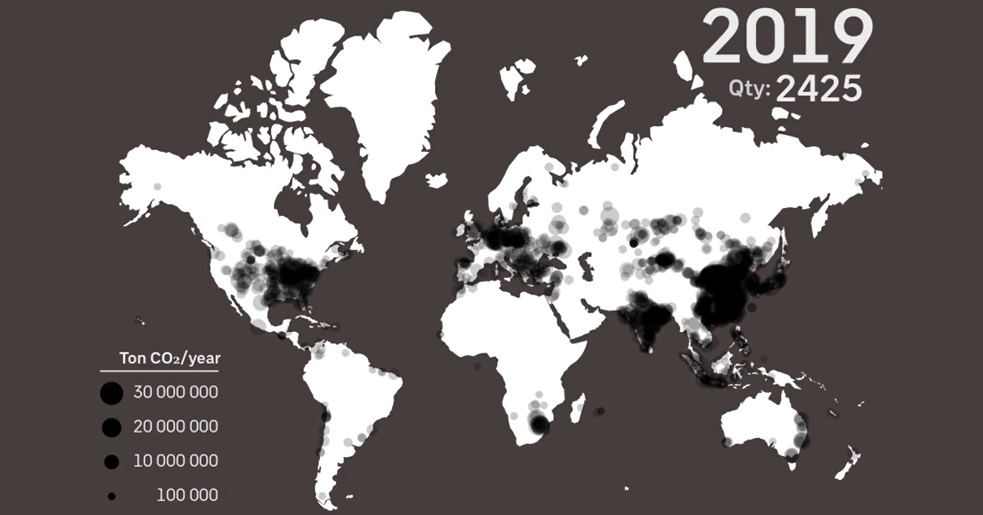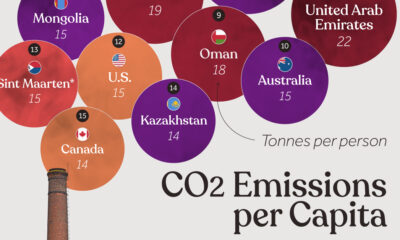Energy
Every Coal Power Plant in the World (1927-2019)
If you live in a developed country, it’s been clear that the appetite for coal power is falling.
Not only has coal been singled out as a primary source of carbon emissions and air pollution, but it’s also been getting phased out in favor of cheap natural gas in some regions around the world.
In the U.S., electricity generation from coal has been dropping since the late 2000s, and in Europe the departure from coal has accelerated even quicker. In fact, it’s estimated that European coal power output could fall 23% in 2019 alone.
A Different Global Story
However, despite a growing consensus around the use of thermal coal in the West, the global story is actually quite different.
Today’s animation from SVT Nyheter details every coal power plant in the world from 1927 to 2019, and it shows that coal power — especially in South Asia — has continued to ramp up.
As of 2019, there are an estimated 2,425 coal-fired power plants in the world, combining for an operating capacity of about 2,000 GW and roughly 15 billion tonnes of CO₂ emissions.
Global Tipping Point?
Since 2010, there have been hundreds of new coal power plants commissioned — and almost all of them can be found somewhere in Asia:
| Country | Coal capacity (2010) | Coal capacity (2018) | % change (2010-2018) |
|---|---|---|---|
| 🇨🇳 China | 630,238 MW | 972,514 MW | +54% |
| 🇮🇳 India | 100,037 MW | 220,670 MW | +121% |
| Other Asia | 127,515 MW | 191,088 MW | +50% |
However, it seems that this could be the year that the story changes.
Preliminary data suggests that Indian coal consumption could drop in 2019 for the first time in over a decade. Meanwhile, it’s expected that China’s growing coal capacity could be fully offset by decreasing use of the fossil fuel in developed nations.
As a result, according to Carbon Brief, global coal power generation could fall 3% in 2019:
If this trend continues, it could be a sign of a tipping point in global coal consumption — and if the sentiment around coal shifts the same way in China, the potential impact could be amplified even further.
Will 2020 provide additional evidence towards a global sea change in coal dependence, or is 2019 just a blip on the radar?
Energy
The World’s Biggest Nuclear Energy Producers
China has grown its nuclear capacity over the last decade, now ranking second on the list of top nuclear energy producers.

The World’s Biggest Nuclear Energy Producers
This was originally posted on our Voronoi app. Download the app for free on Apple or Android and discover incredible data-driven charts from a variety of trusted sources.
Scientists in South Korea recently broke a record in a nuclear fusion experiment. For 48 seconds, they sustained a temperature seven times that of the sun’s core.
But generating commercially viable energy from nuclear fusion still remains more science fiction than reality. Meanwhile, its more reliable sibling, nuclear fission, has been powering our world for many decades.
In this graphic, we visualized the top producers of nuclear energy by their share of the global total, measured in terawatt hours (TWh). Data for this was sourced from the Nuclear Energy Institute, last updated in August 2022.
Which Country Generates the Most Nuclear Energy?
Nuclear energy production in the U.S. is more than twice the amount produced by China (ranked second) and France (ranked third) put together. In total, the U.S. accounts for nearly 30% of global nuclear energy output.
However, nuclear power only accounts for one-fifth of America’s electricity supply. This is in contrast to France, which generates 60% of its electricity from nuclear plants.
| Rank | Country | Nuclear Energy Produced (TWh) | % of Total |
|---|---|---|---|
| 1 | 🇺🇸 U.S. | 772 | 29% |
| 2 | 🇨🇳 China | 383 | 14% |
| 3 | 🇫🇷 France | 363 | 14% |
| 4 | 🇷🇺 Russia | 208 | 8% |
| 5 | 🇰🇷 South Korea | 150 | 6% |
| 6 | 🇨🇦 Canada | 87 | 3% |
| 7 | 🇺🇦 Ukraine | 81 | 3% |
| 8 | 🇩🇪 Germany | 65 | 2% |
| 9 | 🇯🇵 Japan | 61 | 2% |
| 10 | 🇪🇸 Spain | 54 | 2% |
| 11 | 🇸🇪 Sweden | 51 | 2% |
| 12 | 🇧🇪 Belgium | 48 | 2% |
| 13 | 🇬🇧 UK | 42 | 2% |
| 14 | 🇮🇳 India | 40 | 2% |
| 15 | 🇨🇿 Czech Republic | 29 | 1% |
| N/A | 🌐 Other | 219 | 8% |
| N/A | 🌍 Total | 2,653 | 100% |
Another highlight is how China has rapidly grown its nuclear energy capabilities in the last decade. Between 2016 and 2021, for example, it increased its share of global nuclear energy output from less than 10% to more than 14%, overtaking France for second place.
On the opposite end, the UK’s share has slipped to 2% over the same time period.
Meanwhile, Ukraine has heavily relied on nuclear energy to power its grid. In March 2022, it lost access to its key Zaporizhzhia Nuclear Power Station after Russian forces wrested control of the facility. With six 1,000 MW reactors, the plant is one of the largest in Europe. It is currently not producing any power, and has been the site of recent drone attacks.
-

 Mining2 weeks ago
Mining2 weeks agoCharted: The Value Gap Between the Gold Price and Gold Miners
-

 Real Estate1 week ago
Real Estate1 week agoRanked: The Most Valuable Housing Markets in America
-

 Business1 week ago
Business1 week agoCharted: Big Four Market Share by S&P 500 Audits
-

 AI1 week ago
AI1 week agoThe Stock Performance of U.S. Chipmakers So Far in 2024
-

 Misc1 week ago
Misc1 week agoAlmost Every EV Stock is Down After Q1 2024
-

 Money2 weeks ago
Money2 weeks agoWhere Does One U.S. Tax Dollar Go?
-

 Green2 weeks ago
Green2 weeks agoRanked: Top Countries by Total Forest Loss Since 2001
-

 Real Estate2 weeks ago
Real Estate2 weeks agoVisualizing America’s Shortage of Affordable Homes















